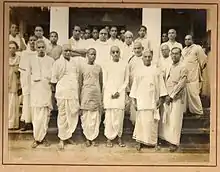Veshti
Veshti (dhoti) is a term for a white unstitched cloth wrap for the lower body in Tamil Nadu. Veshti is a part of the traditional attire consisting of Kurta and Angvastra. The garment is a single piece of cloth and similar to dhoti, one of the earliest draped garment of India. Veshti has beautiful borders. Prime Minister dressed in Karai veshti when he welcomed the Chinese President in Tamil Nadu.[1][2][3][4][5][6][7][8]

Style
Like many wrap clothes, Veshti varies in wearing style. It is wrapped around the waist, secured by a corner being tucked beneath the wrapped cloth. Veshti wearing style is simple. It is worn as Sarong, unlike dhoti, which is looped between the legs.[9] A belt is also used over it (less popular now) just below the closing.[1]
Men and women both wear it. For women, the drape is known as Veshti-mundu.[1][10]
Political identity
Various border (Saffron, red, green, and blue) colors of Veshti represent different political parties' identities in India.[9][11]
See also
References
- Saris: An Illustrated Guide to the Indian Art of Draping. Shakti Press International. 1997. pp. 30, 32. ISBN 978-0-9661496-1-6.
- Ravi, Srilata (2008-04-01). "Tamil identity and diasporic desire in a Kollywoood comedy: Nala Damayanti (2003)". South Asian Popular Culture. 6 (1): 45–56. doi:10.1080/14746680701878547. ISSN 1474-6689.
- India Today. Aroon Purie for Living Media India Limited. October 1995. p. 17.
- "News updates from Hindustan Times at 9 PM: A message from PM Modi in dhoti, angavastram to President Xi and all the latest news at this hour". Hindustan Times. 2019-10-11. Retrieved 2021-01-22.
- "Veshti-Shirt-Angavastram; PM Modi dons the traditional Tamil Nadu outfit for Jinping meet". Zee News. 2019-10-11. Retrieved 2021-01-22.
- "veshti: Latest News & Videos, Photos about veshti | The Economic Times". The Economic Times. Retrieved 2021-01-22.
- "For Weavers of Karai Veshti in TN, It Has Never Been So Good". The New Indian Express. Retrieved 2021-01-23.
- Gopi, Rashmi (2017), Mitra, Iman Kumar; Samaddar, Ranabir; Sen, Samita (eds.), "Ayurveda Tourism: Issues of Development and Gender in Contemporary Kerala", Accumulation in Post-Colonial Capitalism, Singapore: Springer, pp. 165–187, doi:10.1007/978-981-10-1037-8_9, ISBN 978-981-10-1037-8, retrieved 2021-01-24
- Dasgupta, Reshmi R. "Cocktail Conversations: Veshti Vs Dhoti". The Economic Times. Retrieved 2021-01-24.
- Anawalt, Patricia Rieff (2007). The Worldwide History of Dress. Thames & Hudson. p. 232. ISBN 978-0-500-51363-7.
- Kannangara, Nisar (2019-06-01). "The politics of clothing in postcolonial Indian democracy". Clothing Cultures. 6 (2): 237–247. doi:10.1386/cc_00014_1.
![]() Media related to Veshti at Wikimedia Commons
Media related to Veshti at Wikimedia Commons
